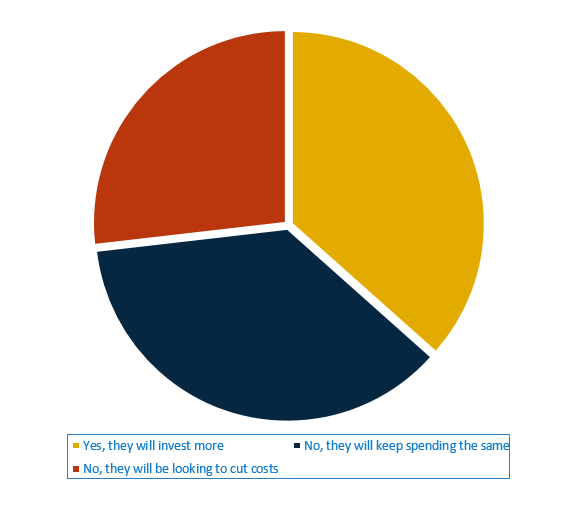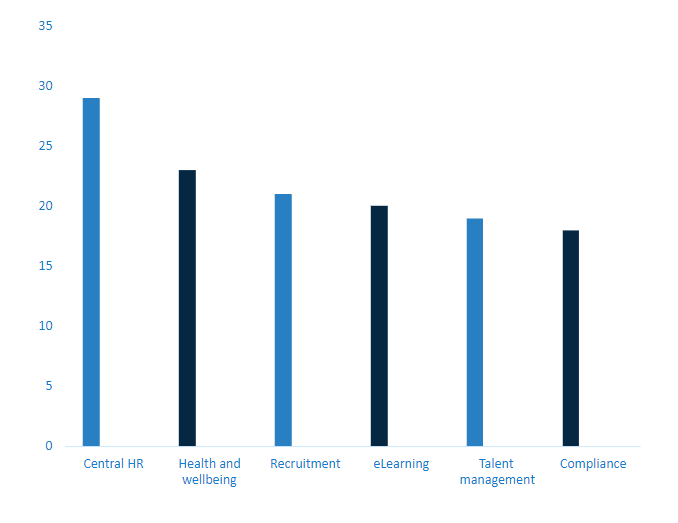2023 was a busy year for HR professionals. Alongside all the usual internal challenges that teams faced – such as supporting line managers, maintaining employee wellbeing and supporting career development – UK-based HR teams were hit by the ramifications of broader, macroeconomic trends such as the spiralling cost of living and continued skills gaps and shortages.
So what might 2024 have in store? A lot can happen in 12 months, but Ciphr’s own experts have gazed into their proverbial crystal balls to share their views on what 2024 has in store for the HR profession and how HR software like Ciphr’s can help.
In this article:
- Which trends are affecting UK organisations and their HR teams the most?
- Will organisations increase their investment in HR technology?
- Which areas of HR functionality will organisations invest in?
- What will be the major drivers behind HR tech investment?
Five challenges for HR in 2024
- Finding the right talent in a difficult market
- Offering competitive salary and benefits packages
- Skills shortages
- Getting HR recognised at board level as a strategic force
- Making data-driven decisions
HR trends 2024: the big picture impacting HR
In November 2023, we conducted an internal poll about what the 2024 HR landscape might look like. More than 40 staff members participated across multiple departments, with 26% of respondents holding a CIPD qualification. Here are some of our key findings:
Which trends are affecting UK organisations and their HR teams the most?
- Rising cost of business – 63% of respondents said significant affect; 29% said moderate affect
- Rising cost of living/wage expectations – 66% said significant affect, 22% said moderate affect
- Mental and physical wellbeing concerns – 39% said significant affect, 46% said moderate affect
Other key factors include immigration, skills shortages, growth of hybrid/remote working and threat of UK recession.
How will spending on HR software change?
Here are the changes we anticipate:
Do you think organisations who are looking for a new HRIS systems provider will increase their investment in HR technology in 2024?
- Yes – 36% of respondents
- No, they will keep spending the same – 36%
- No, they will be looking to cut spending – 27%

Which areas of HR technology functionality would you expect organisations to invest more in in 2024?
- Central HR systems – 61% of respondents
- Health and wellbeing – 56%
- Recruitment software – 51%
- eLearning courses – 49%
- Talent management – 46%
- Compliance – 44%

What will be the major drivers behind HR technology investment in 2024?
- Cost saving – 76% of respondents
- Better integration with other business applications – 76%
- Desire for greater efficiency/reduce manual processes – 73%
- Better user experience – 61%
- Remote/hybrid workforce needs access to HR data anywhere – 56%
- Want to automate more HR admin tasks – 56%
Five challenges for HR in 2024
Our internal survey asked how significant certain challenges would be to UK organisations and their UK teams in 2024 – here are the top five challenges according to our experts.
1. Finding the right talent in a difficult market
Challenges could be:
- Talent team/line manager capacity
- Delivering a great candidate experience
- Offering a realistic experience of the role and working environment during the hiring process
- Recruiting for hybrid or remote-only roles
- Ensuring diversity of hire
Solutions to these challenges include:
- Using AI in recruitment – utilise AI tools for tasks like CV screening, candidate matching and interview scheduling. AI can analyse data to identify qualified candidates and enhance recruitment strategies
- Virtual reality for assessments – use VR technology to assess candidates’ responses to realistic, simulated environments. This can be an effective way to gauge performance
- Chatbots for screening and Q&A – leverage AI-powered chatbots for initial candidate screening and answering applicant queries. Remember, however, that human assessment remains essential for gauging qualities like work ethic and culture fit
- Onsite and hybrid role considerations – adapt to employees’ growing preference for remote work by improving processes for evaluating the soft skills necessary for remote roles, such as time management and communication
- Skills-based hiring – embrace skills-based hiring, focusing on candidates’ actual skills rather than just their formal qualifications, to enhance diversity and efficiency in recruitment. Our recruitment software supports blind recruitment, which hides sensitive data such as name, gender and age from managers. This empowers your hiring managers to make more unbiased hiring decisions
2. Offering competitive salary and benefits packages
Top challenges are:
- Lack of pay transparency
- Inconsistency in flexible work arrangements
- Demand for more comprehensive wellbeing support
- Overlooking the diversity of your workforce and their differing needs
- Lack of time or skills to make informed decisions about reward packages
- Commuting (cost and distance)
Potential solutions could be:
- Pay transparency –provide clear information on how pay is determined to promote fairness and build trust
- Flexible work arrangements – include flexible work options in compensation packages to attract and retain talent
- Wellness programmes – expand wellness programmes to include mental health support and financial wellness initiatives. HR software such as Ciphr’s allows you to list all your wellness benefits and policies in one place, so your employees can easily access them at any time
- Diversity and inclusion – focus on diversity and inclusion (D&I) in compensation practices for ethical and business success. Not sure where to start when it comes to D&I? We offer both consultancy services and eLearning modules on everything from neurodiversity at work to microaggressions to help you decrease discrimination and create a more inclusive environment
- Artificial intelligence in compensation analysis – use AI to analyse compensation data for informed decision-making
- Remote work – offer different remote work options as part of compensation packages
3. Skills shortages
Skills shortage challenges often include:
- Retention and recruitment
- Lack of skills and a competitive market
- Technology and ethical considerations
Solutions could be:
- Embrace technology and automation – automation and AI are reshaping the workforce, creating demand for technology specialists and managers. Upskill your people to prepare for emerging roles and specialisms, and to make full use of your existing technology to boost productivity and innovation
- Strategic workforce planning – identifying future roles and skills is crucial. Effective information management, including robust data on available and required skills, will support strategic workforce planning. Ciphr’s HR software allows you to monitor performance, track skills gaps within your employees and make use of powerful analytics to strengthen strategic people decisions
- Upskilling existing employees – focusing on building new skills among current employees while automating routine work can improve profitability and employee motivation. This approach also aids in addressing talent shortages cost-effectively. A learning management system such as Ciphr’s, complete with off-the-shelf eLearning content, can help you provide learning opportunities to your employees in an engaging and meaningful way
- Renting talent and outsourcing – developing outsourcing partnerships and tapping into the gig economy can bring in specialised skills. This approach allows companies to adapt quickly to changing skill demands
- Acquiring talent from unconventional sources – identifying commonalities between different occupations and sourcing talent from diverse sectors can help in filling skill gaps. This may require some upskilling or retraining but can be an effective solution
- Rapid and agile reallocation of staff – reskilling and redeploying workers in shrinking occupations can help meet new talent demands. This requires shifting assessment methods from qualifications and career histories to underlying skills
- Flexibility in work arrangements – flexibility, including remote or hybrid work options and adaptable hours or shift patterns, remains a powerful tool for job attraction and retention, especially for smaller companies competing with larger firms
- Four-day work weeks – offering four-day work weeks, particularly in less remote-friendly occupations, can be an effective strategy for attracting talent. This trend has been rising, although it remains a niche phenomenon
4. Getting HR recognised at board level as a strategic force
These challenges are:
- Being regarded as ‘just’ HR
- Being perceived as an administrative function
- Making your voice heard – even if you already have a seat at the boardroom table
- Lack of recognition for strategic contribution
- Unclear business value
- Underutilisation of HR technology
Solutions could be:
- Position HR as a strategic advisor – become trusted advisors to leadership, guiding talent acquisition strategies and workforce planning
- Act as a problem solver – address complex workforce challenges, from conflict resolution to talent retention
- Become a mentor and coach – nurture talent within HR and across the organisation, coaching managers on effective leadership
- Drive alignment – align HR strategies with company goals, fostering a unified workforce
- Link culture to performance – show how culture impacts outcomes and business results
5. Making data-driven decisions
Challenges often include:
- Data quality and governance
- Privacy and ethical considerations
- Integration of data sources
- Cultural shift towards data literacy
Some solutions could be:
- Invest in analytics tools and training – adopting user-friendly analytics tools and investing in training programmes is vital to leveraging analytics tools effectively
- Align HR metrics with organisational goals – aligning HR metrics with organisational goals ensures that data-driven decisions support the overall business strategy
- Use of data for talent retention – HR departments should use data analysis to show the bottom-line impact of activities, such as reporting on employee engagement levels, company culture and job satisfaction. This helps in making informed decisions to retain top talent and boost performance. Much of this data can be found inside HR software like Ciphr’s
- Investing in technology for access to information – utilising technology for data collection about people and the market can provide a competitive edge. Effective analysis of this data aids in making informed decisions
- Adoption of AI-powered HR solutions – AI-powered HR solutions, such as AI learning, are increasingly being used to support learning and growth. Investing in such solutions is becoming a significant trend among HR professionals
- Access to live and up-to-date data – relying on current data, rather than outdated reports, is essential for making accurate decisions about compensation and recruitment strategies
- Reimagining company cultures for wellbeing – it’s crucial for HR leaders to prioritise wellbeing and use technology to stay competitive. Creating a company culture that values employee wellbeing is key for retaining talent
Watch your HR department thrive in 2024
Despite the challenges listed above, there are a host of solutions you as an HR professional can implement to watch your department thrive and grow in 2024. Investing in HR solutions, from HR and LMS to recruitment, can help you meet these challenges head on. Automate tasks, facilitate eLearning, monitor trends through robust reporting and more – all with the help of Ciphr.
If you’d like to learn more about how Ciphr can help your HR department meet their goals this year, download the Ciphr brochure or book a demo today. Or, if you’re still interested in learning more about what 2024 might have in store for HR, watch our recent webinar on HR trends 2024 below.
